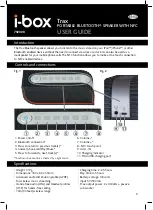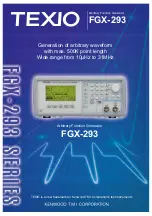
10
EN
GB
GB
GB
GB
GB
GB
GB
GB
GB
GB
GB
GB
GB
GB
GB
SAFETY PRECAUTIONS WHILE CHARGING
■
■
An explosive hydrogen gas is discharged
through vent holes in the battery during the
charging process. Do not allow spark or open
flame around the generator or battery during the
charging process.
■
■
Electrolyte fluid can burn eyes and clothing.
Be extremely careful to avoid contact. If injured,
wash the affected area immediately with large
quantities of water and consult a doctor for
treatment.
■
■
When charging a large capacity battery or
totally discharged battery, excessive current
may force the DC circuit breaker to turn off.
In such cases, use a battery charger to charge
a large battery with AC output.
■
■
Battery defects may cause the DC circuit
breaker to turn off.
Check the battery before replacing the DC
circuit breaker.
3. STOPPING THE GENERATOR
(a) Turn off the power switch of the electric equipment
and unplug the cord from receptacle of the generator.
(b) Allow the engine about 3 minutes to cool down
at no load before stopping.
(c) Turn the engine switch to the position
"
" (CLOSE). (See Fig.
4
-
e
)
q
"
" (OPEN)
w
"
" (CLOSE)
(d)
[Electric starter model]
Turn the key switch to the "
"(OFF) position.
4. OIL SENSOR (See Fig.
4
4
-
r
r
)
q
OIL SENSOR
(a) The oil sensor detects the fall in oil level in the
crankcase and automatically stops the engine
when the oil level falls below a predetermined level.
(b) When engine has stopped automatically, switch off
generator's AC circuit breaker, and check the oil level.
Refill engine oil to the upper level as instructed
on page 5 and restart the engine.
(c) If the engine does not start by usual starting
procedures, check the oil level.
Do not remove OIL SENSOR PROBE when
refilling with oil.
Remove oil filler cap on the opposite side
of carburetor.
CAUTION
Some appliances need a "surge" of energy when starting.
This means that the amount of electrical power needed
to start the appliance may exceed the amount
needed to maintain its use.
Electrical appliances and tools normally come with
a label indicating voltage, cycles / Hz, amperage
(amps) and electrical power needed to run the
appliance or tool.
Check with your nearest dealer or service center
with questions regarding power surge of certain
appliances or power tools.
■
■
Electrical loads such as incandescent lamps
and hot plates require the same wattage to
start as is needed to maintain use.
■
■
Loads such as fluorescent lamps require 1.2
to 2 times the indicated wattage during start-up.
■
■
Loads for mercury lamps require 2 to 3 times
the indicated wattage during start-up.
■
■
Electrical motors require a large starting
current. Power requirements depend on the
type of motor and its use. Once enough
"surge" is attained to start the motor, the
appliance will require only 50% to 30% of the
wattage to continue running.
■
■
Most electrical tools require 1.2 to 3 times
their wattage for running under load during
use. For example, a 5000 watt generator can
power a 1800 to 4000 watt electrical tool.
■
■
Loads such as submersible pumps and air
compressors require a very large force to
start. They need 3 to 5 times the normal
running wattage in order to start.
For example, a 5000 watt generator would
only be able to drive a 1000 to 1700 watt pump.
5. WATTAGE INFORMATION
RG4300iS en̲GU7045 10.6.8 4:35 PM ページ10
Содержание RG3200iS
Страница 1: ...ISSUE EMD GU7130 RU 3ZZ9990551 PRINTED IN JAPAN January 2011 Original ...
Страница 3: ...3 4 5 6 2 3 4 2 1 3 6 1 1 1 2 1 2 1 1 1 2 RG4300iS en GU7045 10 6 8 4 35 PM ページ02 ...
Страница 4: ......
Страница 5: ......
Страница 10: ...4 EN GB GB GB GB GB GB GB GB GB GB GB GB GB GB GB RG4300iS en GU7045 10 6 8 4 35 PM ページ4 ...
Страница 28: ...ISSUE EMD GU7130 RU 3ZZ9990551 PRINTED IN JAPAN January 2011 Original ...













































